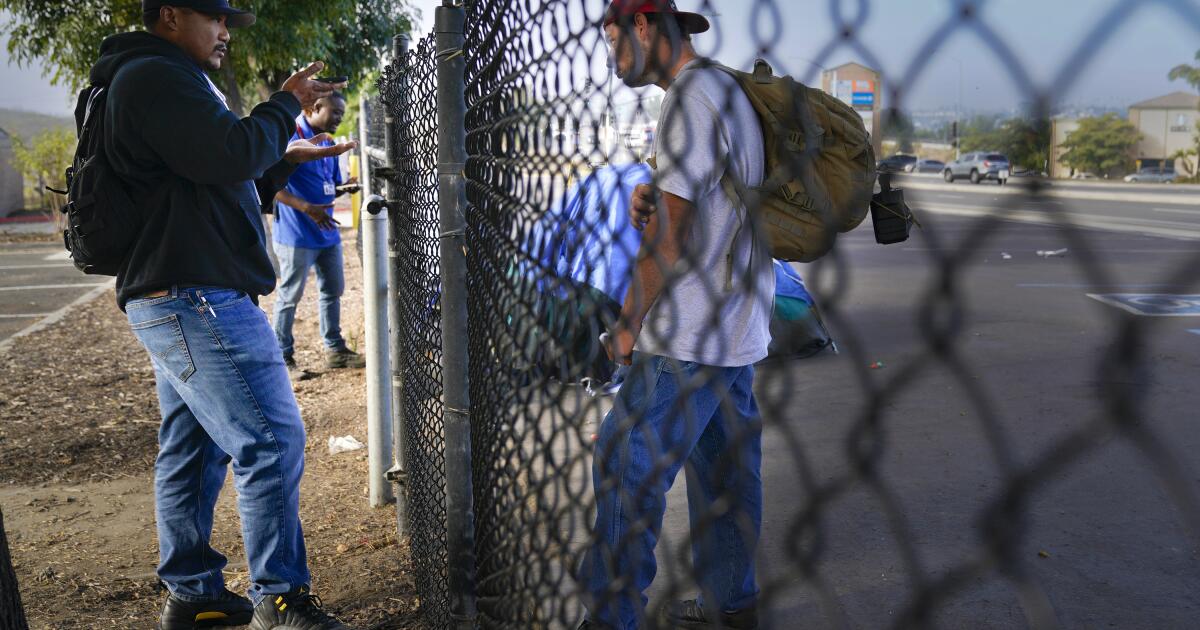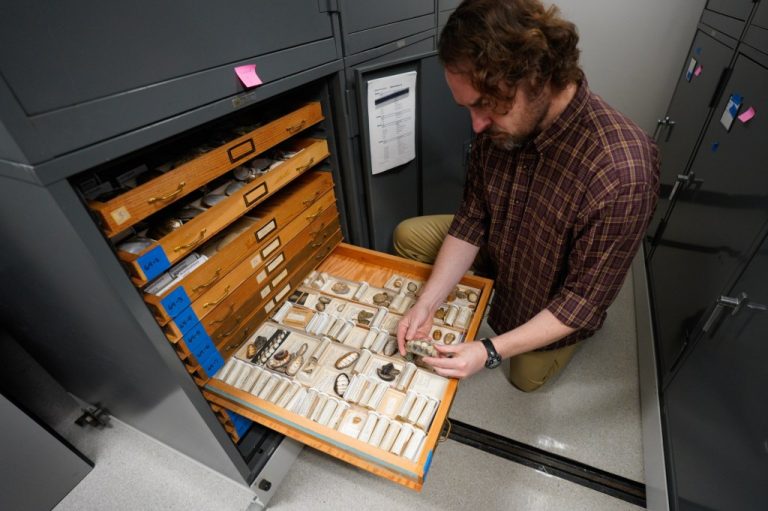
Brice Michalek needed to find one woman.
He knew exactly what to do next: Michalek would load her and her wheelchair into his van and drive to an office. Inside, the woman could get a Social Security card that would let her apply with her partner, who spent years in the Navy, for a housing voucher for veterans. Plenty are available, meaning the couple could be off the street and under a roof within weeks.
If Michalek could find her.
Earlier this month, he parked his van in Santee, stepped into the sun and looked for someone who might know something.
San Diego’s camping ban brought fears that outreach workers, who spend their days trying to connect homeless people with housing, would have a harder time finding clients.
The first months of enforcement did remake the encampment landscape. The San Diego Downtown Partnership found that hundreds of homeless people left the urban center, and even though September’s total ticked up to around 1,300, that was still one of the smallest populations in more than a year.
But staffers at homelessness organizations are mixed as to the law’s effects.
Father Joe’s Villages’ outreach supervisor, Jennifer Wilkens, said the ban “definitely impacted our ability to locate clients.” Craig Thomas, who holds the same job at Alpha Project, said the initial upheaval gave way to larger encampments in fewer areas downtown, simultaneously making it easier to find people and increasing tensions between homeless neighbors. Perhaps as a result, some have been more likely to accept help, according to Heather Lezon, founder and CEO of the Youth Assistance Coalition.
For Michalek, who oversees outreach workers in East County with People Assisting The Homeless, or PATH, San Diego’s ordinance hasn’t changed much.
It’s always been tough finding clients. Plus, the vitriol sometimes directed at people like him can make for complicated days.

On Oct. 18, 2023, Brice Michalek, 35, an outreach worker with PATH, scans a Walmart parking lot in Santee for a client.
(Nelvin C. Cepeda/The San Diego Union-Tribune)
The 35-year-old drove to Santee’s Town Center on a recent Wednesday.
The morning fog had burned away, prompting Michalek to trade his hoodie for a PATH T-shirt. Gray tattoos could now be seen running up both arms, with the ones on the right — a skeleton with a six-shooter, a skull hovering over a line of bullets — coming from a time several years ago when Michalek thought that limb might be blown off.
He parked by a Denny’s. While the woman with the wheelchair didn’t have a phone, she often rested on a nearby trail. Michalek walked that way.
He didn’t see a wheelchair, but he spotted a dark-haired woman near a chihuahua. The dog noticed Michalek first, followed by the owner. At 6 feet, 2 inches tall and around 275 pounds, Michalek is hard to miss.
“Do you normally see a lady in a wheelchair in this location?” he asked.
The woman on the trail seemed to know who Michalek was talking about but said there hadn’t been a sighting in two days. “If she was around the area, she’d be at the trailhead behind Walmart.”
Michalek turned and strode into Walmart’s parking lot.
He felt optimistic. After months of work, the missing Social Security card felt like the last thread keeping this woman and her partner from landing in a home. He’d actually entered her into the region’s Homeless Management Information System exactly one year ago to the day, a fact he didn’t realize until he looked her up on his iPhone.
He can track a lot on that phone, including confirmation that she wasn’t in a shelter.
Michalek turned a corner. On a sidewalk near a line of bushes, two legs stuck out from under a blanket.
He pulled out some water bottles. A hand emerged to take the water, but a muffled voice had no advice about the woman in question.
Michalek continued down the side of the store. Abandoned shopping carts lined the walkway like sentries. Michalek hailed a blonde woman ahead of him. She told him to screw off.
Concrete gave way to a dirt path. Views of the shopping center were now blocked by trees, and the surrounding sagebrush made the area feel surprisingly isolated.
Michalek paused at a fork in the path. A few people were visible in the distance. None of them looked right.
Bicycle wheels clacked behind him. Michalek squinted at the bike’s owner. Dusty red shoes, the start of a beard — the guy looked familiar.
“How you doin’ man?” Michalek said.
The two had previously met. Michalek brought up the woman in the wheelchair. “The hell is she at?”
“Usually up by Denny’s,” the man said. That was bad news. Michalek was just there.
Michalek asked if the man needed anything.
Any food?
Michalek had none.
The man paused, then said, “Maybe if you get a chance to check where I’m at in the housing?”
That Michalek could do. The two huddled over a phone. There was no good news to share, but they scheduled a meeting for the following week.

On Oct. 18, 2023, Brice Michalek, 35, an outreach worker with PATH, speaks with a man who’s been living by the San Diego River in Santee.
(Nelvin C. Cepeda/The San Diego Union-Tribune)
It seemed unlikely that someone in a wheelchair could go far in the brush, so Michalek walked back up the hill. He had another idea about where she could be.
Michalek was partway through the Walmart parking lot when he spotted a different woman.
She was White, standing next to a car and giving the outreach worker a hard look.
Michalek’s biological mother was Japanese, his father Black. When surrounded by people who don’t look like him, Michalek sometimes wonders what they’re thinking. Looks can trigger feelings that he’s unwanted.
Michalek got closer. The woman kept staring.
He finally said, “Good morning, how you doing?”
The woman said nothing.
Michalek filled the silence. “Have a good day, too.”
Without a word, the woman climbed into a passenger seat. Michalek kept walking.
Outreach workers face a growing workload.
Just last month, nearly 1,200 people became homeless for the first time in San Diego County, according to the Regional Task Force on Homelessness. During the same period, only 776 were successfully housed.
It was the 18th straight month the crisis has grown faster than it could be contained.
Understandably, Michalek sometimes feels he’s been given an impossible task.
Yet the fact that the only response is to put your head down and get to it is not only intellectually engaging but an odd reminder of one of his last jobs: securing Afghanistan with the U.S. Marine Corp.
His discharge paperwork tersely summarizes Michalek’s role in America’s longest war. “Member participated in Operation Enduring Freedom.” “Machine gunner, 09 years, 02 months.” “Purple Heart.”
He liked the Marines. Even when he had to live out of a truck in the desert. After getting out in 2017, he returned to his hometown of El Cajon and eventually got a job helping people who sometimes live out of their own trucks.
Michalek pulled out of Walmart and drove toward a Vons.
He knew of a recycling machine outside where cans could be exchanged for money. Maybe the woman was there.
Michalek slowed as he passed the store. The machine was gone, and there was no wheelchair.
He exhaled.
The van weaved between shoppers. A Petco passed by the window, then a Barnes & Noble. Michalek parked at a Jamba Juice and walked toward a trolley stop. From overhead speakers, a trumpet solo echoed across the platform.
He passed an Armed Forces Career Center, turned right and spotted a green walker in a corner. A blanket covered the top.
As Michalek looked at it, a door opened on the side of the building. A bearded security guard stood on the threshold, blinking. He looked like he’d just woken.
“Have you seen an older White lady with a — in a wheelchair?” Michalek asked.
He held up a photo on his phone.
“I haven’t seen her in a while,” the guard said. “Two weeks, it is?”
Michalek moved on.
Trucks hissed. Carts rattled. The longer he walked, the fewer people seemed visible.
Michalek was approaching the corner of Cuyamaca Street and Town Center Parkway when he spotted a wheelchair.
It wasn’t the one he wanted. This chair held a stack of trash bags and was pushed by an elderly man in a yarmulke. Still, the guy might need help.
Michalek leaned in and asked to talk. The man turned his wheelchair around in the street and pushed it back toward the sidewalk.
In the process, they passed a thin boy, maybe 16, standing with a skateboard.
“Why don’t you leave old man alone?” the boy said, his words slurred.
“I’m just trying to help him, brother,” Michalek responded.
The kid snapped. In a raised voice he spewed a stream of profanity at Michalek.
“Very good, sir, have a good day,” the outreach worker said before backing up to where the elderly man had stopped. Michalek crouched down, pulled out his phone and began quietly asking questions.

In Santee on Oct. 18, 2023, Brice Michalek, 35, an outreach worker with PATH, speaks with an elderly man who recently arrived by bus from San Clemente.
(Nelvin C. Cepeda/The San Diego Union-Tribune)
From the corner, the kid glared. He slapped the crossing button. The light didn’t change. He slapped it again. Then he picked up his board, strode toward Michalek and planted his feet. All he needed to do was swing out his arms and the board would strike the outreach worker in the head.
Michalek looked up. “Bro, I need you to get out of my face.”
The boy stared. Perhaps he saw that Michalek was twice his size. Maybe part of him registered that the United States once spent an enormous amount of money turning Michalek into one of the most effective fighters in human history.
Regardless, the boy retreated.
Michalek turned back to the man in the yarmulke. He could feel the adrenaline inside him. It didn’t show on his face, but Michalek knew he’d need to work this out at the gym.
The interview wrapped up and Michalek stood. Before long he was again passing the trolley tracks. It was, literally and figuratively, the end of the line. Michalek couldn’t think of where else the woman might be.
He moved on to other tasks.
The next day, he returned to the trail by Denny’s. Two people were sitting in wheelchairs. Michalek thought he recognized one, a man in reflective sunglasses.
Michalek approached and, once again, asked if anyone had seen the woman.
“She’s right here,” the man said.
The second person turned. It was her.
Michalek knew what he hoped to do next.





